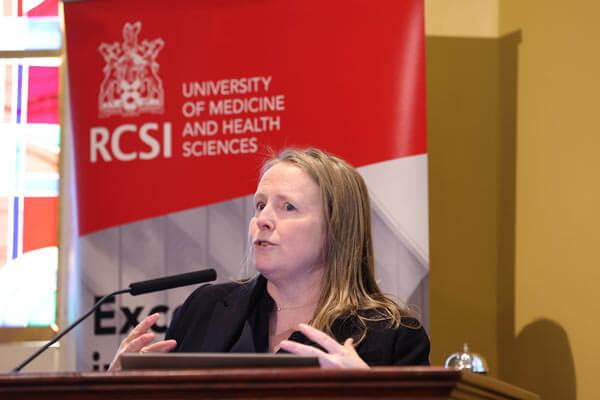
A new €32 million Education and Research Centre (ERC) at Connolly Hospital has been officially opened by RCSI University of Medicine and Health Sciences.
RCSI President Deborah McNamara formally opened the new facility. Minister for Finance, Jack Chambers T.D. and Minister for Children, Equality, Disability, Integration and Youth, Roderic O’Gorman also attended.
The new centre joins the Smurfit Building, Education and Research Centre at Beaumont Hospital as RCSI’s second major clinical centre of academic excellence in Ireland.
Designed by McCauley Daye O’Connell Architects and constructed by Felix O’Hare & Co Ltd. the three-storey building was designed with two distinct interlocking blocks for student, academic, faculty and administration functions with a communal atrium area linking both, providing amenity and support space for students and staff.
RCSI said the Centre would greatly enhance the student experience for the Graduate Entry Medicine students based at Connolly and for all other RCSI students while on clinical rotations at the hospital. Along with tutorial rooms and a large lecture theatre, it included a mock operating theatre, practical skills rooms and a large public area.
The new facility would also provide increased capacity for RCSI’s translational research and would be the location for a new clinical research centre.
Funded by the HSE, a new Hospital Integrated Pathology laboratory situated on the second floor would replace the existing hospital laboratory. This state-of-the-art facility would significantly enhance laboratory capacity in the hospital, providing essential diagnostic capacity for the communities of West Dublin, North Kildare and South County Meath.
Minister for Finance, Jack Chambers T.D. said: “This new Education and Research Centre is an important addition to Connolly Hospital in Blanchardstown. RCSI is at the forefront of health sciences education in Ireland and internationally. This new centre gives students a dedicated space to learn and hone their skills in a state-of-the-art facility as well as providing additional capacity for cutting-edge research. I am particularly pleased that the building also includes new HSE pathology laboratories. This is a great example of an academic institution working in partnership with the health service for the benefit of medical students, patients and the local community.”
Minister for Children, Equality, Disability, Integration and Youth, Roderic O’Gorman . said, “I am pleased to welcome the opening of the new RCSI Education and Research Centre at Connolly Hospital, Blanchardstown. The students who are educated here will go on to become the healthcare leaders of the future and they will have had the benefit of being educated in a world-class learning environment on the campus of a busy acute hospital which is meeting the needs of patients from Dublin 15 and beyond. The inclusion of HSE laboratory space will enhance diagnostic capacity for the hospital and benefit patients.”
Professor Cathal Kelly, Vice-Chancellor, RCSI University of Medicine and Health Sciences said, “We are delighted to officially open the new RCSI Education and Research Centre at Connolly Hospital. This future-focused development reflects the University’s commitment to Connolly hospital and the broader RCSI Hospital Group, as well as our long-standing partnership with the HSE. It will provide a world-class learning environment for the RCSI students at Connolly, as well as additional research infrastructure.
“The inclusion of a new HSE pathology laboratory is a reflection of the strength of our partnership with the HSE, as well as our commitment to supporting improvements in patient care,” added Professor Kelly.
Building on RCSI’s commitment to sustainability, the Centre is ‘A’ rated for energy efficiency. It was designed using the Energy Efficient Design approach to meet the highest standards in energy efficiency. Some of the key features are solar electricity generation on site, green roofs, use of heat pumps, natural ventilation and selection of only the most highly energy efficient building materials.

